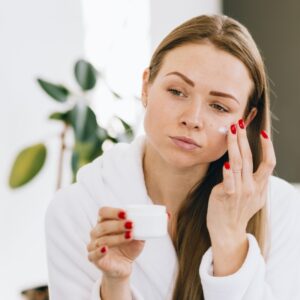Making your own face cream is a really cool experience in natural skin care. It’s creative, satisfying and you have complete control over what you put on your skin. You can control the texture, scent and action, from a light moisturizing lotion to a rich anti-aging blend. But even if your ingredients are all-natural, safety is still important. Any product that comes in contact with your skin must be clean, stable and well-balanced.
If you ever plan to share or sell your creations, it is essential to know what the EU standards for moisturizers are. The European Union has clear standards to ensure that face creams are safe, stable and suitable for everyday use. Whether you are a beginner learning how to make face cream or an experienced formulator perfecting your recipe, this guide will help you make a natural face cream that is both effective and fully compliant with EU skin care safety principles. At YouWish, we believe that natural skin care should be both creative and responsible. If you understand how ingredients work together, how to protect your formula from contamination and how to choose the right essential oil for skin care, you can make creams that look beautiful, feel nice and work superbly.
Why safety and compliance with EU standards matter in skin care
It’s not always the case that “natural” equals “automatically safe,” as many people think. If the formula is not balanced, even the mildest ingredients can oxidize, destabilize or react unexpectedly. This is why the EU places a strong emphasis on safety regulations for all manufacturers of skin care products, both small, artisan companies and large cosmetic companies.
Labeling, appropriate packaging, microbial stability and purity of ingredients are all covered by EU standards for moisturizers. This ensures that your product will not deteriorate over time, cause irritation or spoil quickly. It is important to be knowledgeable and methodical, but following these guidelines does not have to be difficult. Consider compliance as part of the creative process when making face cream. You are creating something reliable, not just something that feels and smells nice. A safe formula relies on clean tools, good hygiene and accurately measured ingredients. Moreover, these steps become a natural part of your routine once you get used to them.
Choosing the right ingredients for a natural face cream
A natural face cream is the ideal combination of active ingredients that are good for the skin, soothing waters and nourishing oils. The emphasis is on the quality and balance of natural ingredients rather than artificial additives or fillers.
Three primary components form the basis of the structure of any face cream:
- The water phase, usually aloe vera juice, floral water or distilled water for hydration.
- The oil phase is a mixture of butters and vegetable oils that soften and nourish the skin.
- The emulsifier creates a smooth, creamy texture by binding the two phases together.
Use oils that absorb quickly, such as jojoba, apricot kernel or sweet almond, for light moisturizers. Richer ingredients, such as avocado oil or shea butter, nourish drier skin longer. Adding humectants, such as glycerin or hyaluronic acid, keeps your face cream hydrated and fresh all day by drawing moisture into the skin. The power of essential oils for skin care also begins here. These powerful natural extracts offer practical benefits in addition to their fragrance. Geranium balances sebum production, frankincense promotes skin firmness and renewal, and lavender and chamomile soothe and soften the skin. Always use cosmetic-grade essential oils and dose carefully; usually 0.5-1% of your total formula is sufficient.
YouWish offers a wide range of natural oils, butters, emulsifiers and essential oils for skin care products. Each product has a detailed description and recommended use amounts to help you create products that are both safe and effective.
How to make face cream at home: step by step
If you’re ready to make face cream at home, the process is easy once you understand the basics. You can start with a small amount, take notes as you go, and gradually improve your formula. Here’s a step-by-step approach:
1. Prepare your workspace and tools
Clean your jars, spoons and mixing bowls. Clean surfaces prevent bacterial growth and keep your cream fresher longer.
2. Warm and mix your phases
Heat the oil and water phases separately to about 70 °C. Slowly pour the water phase into the oil phase while continuing to stir. After emulsifying, allow the mixture to cool before adding delicate ingredients such as vitamins or essential oils for skin care.
3. Adjust the texture
If your natural face cream feels too thick, add a little distilled water; if it is too thin, add more butter or emulsifier. Each ingredient affects the final feel; experiment until you reach your desired consistency.
4. Check pH
A balanced pH between 4.5 and 6.5 ensures that your cream is compatible with the skin’s natural barrier. With simple pH strips, you can easily test and adjust this.
5. Package and store
Pour the cream into clean jars or airtight pump bottles. Label each batch with the production date and ingredients used. Store in a cool, dry place, preferably out of the sun.
Making your own face cream gets easier with a little practice. Once you understand the process, you can experiment with active ingredients such as coenzyme Q10, panthenol or botanical extracts to make your moisturizer even more personalized.
Essential oils for skin care: fragrance, function and balance
Using essential oils for skin care gives your face cream a luxurious feel, but more importantly, these oils can also support specific skin goals. They are powerful, concentrated ingredients, so precision and care are essential.
Lavender and chamomile are great options for dry or sensitive skin. They help maintain balance and reduce redness. Rose and frankincense add firmness and radiance to tired or mature skin. Tea tree and geranium can help tone and purify oily skin without affecting its natural moisture.
Adding essential oils to your natural face cream makes application an even finer experience and gives it a wonderful scent. Just keep in mind that a little already has a lot of effect. Always use the recommended dilution ratios, as too much can cause irritation. When making face cream, think about combining scent families for harmony, such as citrus with soft woods or floral notes with earthy tones. As in nature, balance is created by the right mix.
Keeping your face cream fresh and stable
When your cream is ready, it is important to store it properly. Because natural formulas do not contain powerful synthetic preservatives, they are more fragile. To avoid contamination, use a clean spatula each time you apply your face cream and store it in tightly sealed jars.
By adding a mild preservative approved for natural cosmetics, you extend the shelf life of your water-based creams. To enjoy them as long as possible, make small quantities and store them in a cool place away from moisture. Always keep an eye on your cream; if the texture, color or smell changes, it’s time to make a new one. See it as an opportunity to improve your recipe by adding better oils or a new essential oil for skin care.
Frequently Asked Questions
V1. Do I have to follow EU regulations when making face cream for personal use?
If you make face cream only for yourself, you do not need to submit official documents. However, it is helpful to follow the EU regulations for moisturizers. That way you will learn how to choose safe ingredients, avoid contamination and maintain product quality. If you ever decide to sell your natural face cream, you will already know what is required by EU cosmetics legislation, from ingredient safety to labeling.
V2. What is the best way to make face cream last longer?
Homemade creams do not contain strong synthetic preservatives, so freshness depends on hygiene and storage. Always use clean jars and utensils, do not touch the cream with your fingers and store in a cool, dry place. For water-based formulas, consider adding a mild, natural preservative. These small steps make a big difference in keeping your natural face cream safe and stable.
V3. Which essential oils are safe for face creams?
When choosing an essential oil for skin care, choose mild, non-irritating options. Lavender, chamomile, geranium and frankincense are suitable for most skin types. If you have oily or blemished skin, tea tree or rosemary can help purify your skin. Always dilute essential oils appropriately, about 0.5-1% of your total formula, and test your mixture on a small patch of skin before using it on your face.
V4. Can I make face cream without an emulsifier?
An emulsifier helps bind oil and water, creating a smooth and stable texture. Without an emulsifier, your face cream will start to separate over time. You can use natural emulsifiers such as Olivem 1000, Emulsan or beeswax-based blends for homemade skin care products. These options help keep your natural face cream cream cream creamy and well blended, without synthetic additives.
V5. How many essential oils can I combine in one face cream?
You can mix several essential oils for skin care, but balance is important. Start with two or three complementary scents, for example, lavender and frankincense for tranquility, or geranium and citrus for freshness. Keep the total concentration low to protect sensitive facial skin. Too many oils at once can overwhelm the formula and increase the risk of irritation.
Conclusion: create with confidence and care
When you make face cream, you combine creativity with attention. The time you take to mix oils, select scents and create something that is all yours is reflected in every jar. However, it also reminds you that confidence is the key to effective skin care. Smooth skin is only one aspect of a truly beautiful natural face cream; another is knowing that your creation is safe, balanced and meets EU standards for moisturizers. Every little detail, from carefully selected oils to pure essential oils for skin care, contributes to a product that feels as good as it looks.
At YouWish, we’re ready to help you, from idea to production. Explore our range of essential oils, face cream bases and cosmetic ingredients, everything you need to create safe, all-natural skin care products that showcase your individuality and attention to detail.

